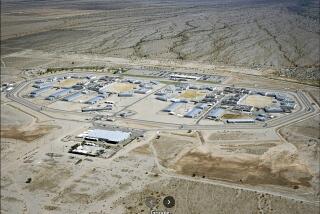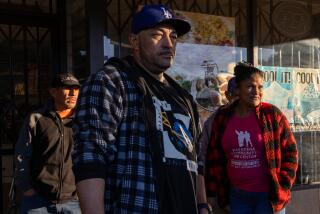‘This is slavery’: U.S. inmates strike in what activists call one of the biggest prison protests in modern history
In his 29 years in prison, David Bonner has mopped floors, cooked hot dogs in the cafeteria and, most recently, cut sheets of aluminum into Alabama license plates.
The last job paid $2 a day — enough to buy a bar of soap at the commissary or make a short phone call.
“This is slavery,” said Bonner, who is 51 and serving a life sentence for murder. “We’re forced to work these jobs and we get barely anything.”
He was speaking on a mobile phone smuggled into his 8-by-12 foot cell in Alabama’s Holman Correctional Facility, where he and dozens of other inmates were on strike.
They’re among a growing national movement of prisoners who have staged work stoppages or hunger strikes this fall to protest dismal wages, abusive guards, overcrowding and poor healthcare, among other grievances.
Prisoners’ rights activists say the coordinated effort is one of the largest prison protests in modern history, drawing in at least 20,000 inmates in at least 24 prisons in 23 states.
State officials have confirmed inmate protests in Michigan, South Carolina and Florida since early September. In California, at least 300 inmates have been involved in hunger strikes at jails in Santa Clara and Merced counties.
In several states, including Virginia, Ohio and Texas, officials have denied claims by activists that strikes have occurred.
Alabama officials acknowledged the protest at the Holman prison, 52 miles northeast of Mobile, though they said it was limited to a one-day strike by 60 inmates who worked in the kitchen and license plate plant — far less extensive than the 10-plus days in September and October that activists described.
“I know there are inmates who are saying there is this big, wide work stoppage but that is just not the case,” said Alabama Dept. of Corrections spokesman Bob Horton.
Horton denied inmate reports that the prison had been on lockdown in response to strikes, which he described as “peaceful.” But he also said he understood some of prisoners’ complaints about living conditions. Holman is “overcrowded and understaffed,” Horton said, adding that state officials were working to fix the problem.
Alabama Gov. Robert Bentley, who visited Holman earlier this year, has described the state corrections system as being “in crisis” and has pushed for funding to build additional prisons.
Known by inmates as “the slaughterhouse” for its death row, the maximum-security Holman prison is considered one of the most violent facilities in the South.
Nearly 1,000 inmates occupy a space built for half that many. Tensions have been escalating throughout this year.
In March, riots broke out. In September, a prisoner stabbed a corrections officer to death. In October, after an inmate committed suicide, prisoners said guards had ignored their screams to come and help the man.
Amid the protests, the U.S. Department of Justice announced this month that it was launching a civil rights investigation into prisons across Alabama to determine “whether prisoners are adequately protected from physical harm and sexual abuse at the hands of other prisoners” and “from use of excessive force and staff sexual abuse by correctional officers.”
Activists celebrated. “I’ve been doing this work for four years, and we’ve never gotten this kind of attention to prisoners’ rights,” said Azzurra Crispino, an activist based in Austin, Texas. “There’s a momentum.”
Crispino is a spokesperson for the Incarcerated Workers Organizing Committee, a group that is part of the Industrial Workers of the World union and has played a key role in coordinating the protests. It has connected prisoners to one another and outside activists, and rallied activists to flood prisons with letters and phone calls on behalf of inmates.
Most states have a prisoner-rights organization headquartered at one of its major prisons. The Free Alabama Movement, for example, is based at the Holman facility.
Leaders in each prison have used contraband smartphones to coordinate work stoppages and broadcast their complaints and demands through Twitter, Facebook, YouTube and blogs. Some inmates have reported being transferred to other prisons or confined in cells as retaliation for organizing.
All of us realize this is a long and protracted struggle. From our perspective, the fact that a strike occurred at all is a win.
— Azzurra Crispino, an activist with the Incarcerated Workers Organizing Committee
Organizers said that although the labor strikes have included only a sliver of the nation’s 2.2 million prisoners, they stand the best chance of spurring change.
Putting prisoners to work is standard practice, but many states don’t pay them, pointing out that although the 13th Amendment of the Constitution outlaws “involuntary servitude,” it makes an exception for work done “as a punishment for crime.”
Correction officials say prison labor gives inmates job skills and a sense of independence, a view supported by some studies. Many prisoners say they wouldn’t mind working but want more pay and protections on par with jobs outside prisons.
The work goes far beyond maintaining the prisons or producing goods for the government. Prison labor often benefits private enterprises.
According to prisoners, the strikes this fall included inmates at the Perry Correctional Institution in South Carolina who work without pay for a furniture company that operates a factory there. In an interview, Bryan Stirling, who heads the state department of corrections, denied there was a strike.
Until it bowed to pressure from prisoner-rights activists last year, the grocery store chain Whole Foods bought tilapia and goat cheese from a supplier that raised its animals using inmate labor in Colorado.
The Florida Department of Corrections website says that inmates working in jobs serving various state agencies saved residents $45 million in taxes in 2014. “Inmates performed almost 5.4 million hours of work in our communities, valued at more than $76 million,” the site reads.
By some estimates, prison workers save individual states and U.S. companies billions a year in wages.
“The prison system right now is just a big old business,” said Carlos Sanders, a 53-year-old death row inmate who goes by the name Siddique Abdullah Hasan and helps lead the Free Ohio Movement from the Ohio State Penitentiary in Youngstown.
“We’ve tried hunger strikes and filing grievances with courts,” said Sanders, who entered prison for robbery and was subsequently convicted of helping plan the murder of a corrections officer during a 1993 uprising. “But since super-economic exploitation is what keeps these prisons alive, we decided a labor strike is the way to go.”
The strikes began on Sept. 9, timed to the 45th anniversary of the deadliest prison uprising in modern American history — a five-day standoff over living conditions at the Attica Correctional Facility in upstate New York that left 33 prisoners and 10 guards dead.
The issue of prisoner rights has periodically garnered public attention over the years, fueled most recently by debates over race and justice that have gripped the country.
A 2010 work stoppage involving thousands of prisoners in Georgia was quickly followed by similar strikes in North Carolina, Washington, Illinois and Virginia. Three years later, 30,000 California inmates refused food — some of them for close to two months — protest the state’s use of long-term solitary confinement.
But the strikes this fall have a breadth that has seldom been seen. That can only translate to increased awareness for a cause that has rarely enjoyed much sympathy from the public.
“All of us realize this is a long and protracted struggle,” said Crispino. “From our perspective, the fact that a strike occurred at all is a win.”
One recent question for activists inside and outside prisons is where prison guards stand on the push for reforms. They spend more time with the inmates than anyone else and have a close-up view of prison conditions. They also naturally have a strong interest in maintaining peace at their workplaces.
Last month at the Holman prison when nine guards didn’t show up for a work shift, inmates took it as support for their strike.
“They tired of the Administration playing games with their lives,” tweeted Robert Earl Council, a 42-year-old death row inmate and Free Alabama Movement co-founder who goes by the name Kinetik Justice.
But the guards have yet to make their stance public, and corrections officials said their lack of attendance didn’t mean they were joining striking prisoners.
This week, according to prison officials, an inmate used an unidentified homemade weapon to attack a guard, who was slashed across the head. He is expected to recover.
“They support us,” Council said. “But they also are afraid of being hurt themselves.”
Jaweed Kaleem is The Times’ national race and justice correspondent. Follow him on Twitter, Facebook and Instagram.
ALSO
A wounded California Guard soldier served four combat tours. Now he’s fighting the Pentagon
Leaders of Oregon wildlife refuge standoff are acquitted of federal charges
UPDATES:
5:15 p.m.: This article was updated to include a comment from a South Carolina corrections official to deny that a strike took place at the Perry Correctional Institution.
This article was originally published at 3:00 a.m.
More to Read
Start your day right
Sign up for Essential California for news, features and recommendations from the L.A. Times and beyond in your inbox six days a week.
You may occasionally receive promotional content from the Los Angeles Times.







